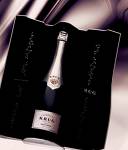 Most wine critics agree that 1996 is indeed an extraordinary vintage for Champagne. The problem is that word got out among Champagne lovers, and many of the best ’96s rapidly disappeared shortly after coming on the market.
Most wine critics agree that 1996 is indeed an extraordinary vintage for Champagne. The problem is that word got out among Champagne lovers, and many of the best ’96s rapidly disappeared shortly after coming on the market.
Don’t even try to find a 1996 Roederer Cristal or Bollinger; they’re long gone. The 1996 Charles Heidsieck was produced in such small quantities that it was sold only in France. Even 1996 Dom Pérignon, which is always produced in rather large quantities, is very difficult to find today.
Well, I have good news for all of you Champagne lovers. After 11 years of aging, the 1996 Krug is finally being released in May, along with Krug’s superb blanc de blancs, the ’96 Clos du Mesnil. I had the distinct honor of being the first person — aside from the Krug family and its oenologists — to taste the 1996 Krug with Olivier Krug Tuesday morning, and it is superb, even now! In fact, I rate it ’99’; the only other Champagne I’ve rated 99 was the 1996 Cristal. I’ve given one ‘100’, to the 1928 Krug.
The 1996 vintage is in fact very much like the legendary 1928. The late Paul Krug, grandfather of Olivier — the current keeper of the Krug flame — and father of Henri and Rémi Krug, was among the first to make this comparison. Olivier Krug recalls his grandfather’s remarks on the occasion of the blending of Krug 1996 — the last vintage to be blended by the three Krug generations — Paul, Henri, Rémi, and Olivier.
‘Throughout his life, my grandfather shunned exaggeration of any kind,’ Olivier recalled, ‘but on this occasion he looked at us and said, ‘I think this may well be the next 1928.’ ‘
Both 1928 and 1996, because of the unusual nature of the climate in those years, share similar characteristics: rich aromas, firm texture, full, ripe flavors combined with extraordinary acidity.
The usual scenario in Champagne is one or the other; for example, the 1989 and 1990 vintages in Champagne had lots of ripe flavors, but could have used more acidity, whereas the 1988 Champagnes had plenty of acidity, but were rather austere in flavor.
Only freakish, eccentric vintages can produce a 1996. The weather in the summer of ’96 was one of contrasts: periods of intense heat followed by heavy rains. The harvest in September was perfect: warm, dry, sunny days, with unusually chilly nights, providing the contrast that winemakers love to see.
Richard Geoffroy, head winemaker of Dom Pérignon, told me that the only Champagne producers who did not do well in ’96 were those who allowed the Pinot Noir to get too ripe; of course, he wouldn’t tell me which ones.
But from my experience tasting the ’96s so far, I would say that most Champagne houses made very good to superb Champagnes in this magical vintage. Who knows? In ten years, I might add another point on to the 1996 Krug!
5
